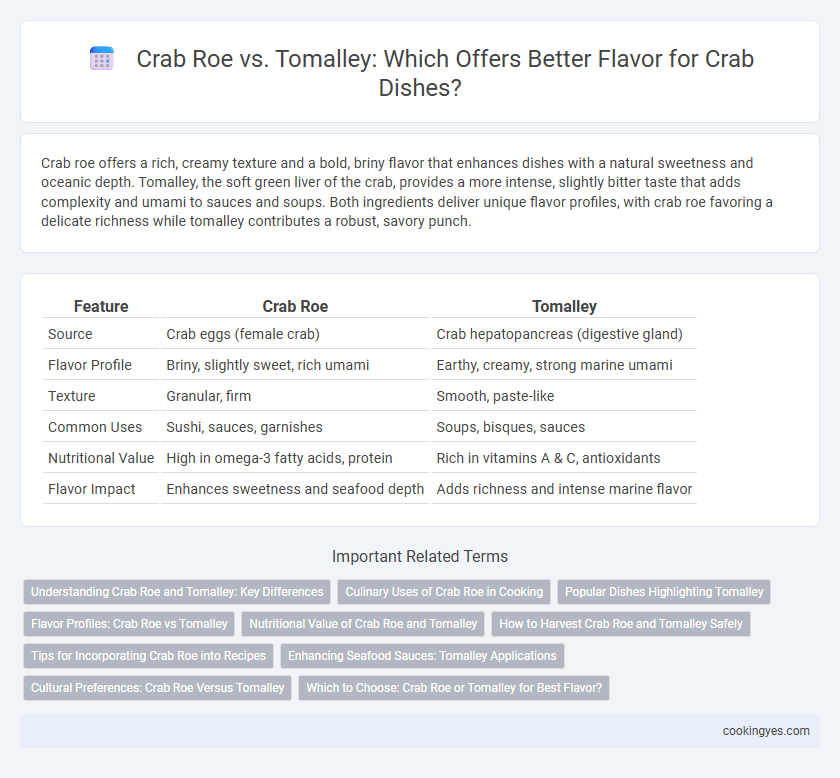Crab roe offers a rich, creamy texture and a bold, briny flavor that enhances dishes with a natural sweetness and oceanic depth. Tomalley, the soft green liver of the crab, provides a more intense, slightly bitter taste that adds complexity and umami to sauces and soups. Both ingredients deliver unique flavor profiles, with crab roe favoring a delicate richness while tomalley contributes a robust, savory punch.
Table of Comparison
| Feature | Crab Roe | Tomalley |
|---|---|---|
| Source | Crab eggs (female crab) | Crab hepatopancreas (digestive gland) |
| Flavor Profile | Briny, slightly sweet, rich umami | Earthy, creamy, strong marine umami |
| Texture | Granular, firm | Smooth, paste-like |
| Common Uses | Sushi, sauces, garnishes | Soups, bisques, sauces |
| Nutritional Value | High in omega-3 fatty acids, protein | Rich in vitamins A & C, antioxidants |
| Flavor Impact | Enhances sweetness and seafood depth | Adds richness and intense marine flavor |
Understanding Crab Roe and Tomalley: Key Differences
Crab roe, the female crab's eggs, delivers a rich, briny flavor with a slightly grainy texture, commonly cherished for its intense seafood essence. Tomalley, the soft, greenish substance found in the crab's body cavity, acts as the liver and pancreas, offering a creamy, buttery taste that enhances dishes with its unique umami depth. While roe provides a vibrant pop of texture and saltiness, tomalley imparts a smooth, luxuriant mouthfeel essential for complex flavor layering in gourmet recipes.
Culinary Uses of Crab Roe in Cooking
Crab roe offers a rich, briny flavor and creamy texture that enhances sauces, soups, and seafood dishes, making it highly prized in culinary applications. Unlike tomalley, which provides a buttery, slightly bitter taste from the crab's hepatopancreas, roe imparts a distinct sweetness and depth, elevating the umami profile in recipes. Chefs often use crab roe to create luxurious stocks, dressings, and spreads, showcasing its versatility in gourmet cooking.
Popular Dishes Highlighting Tomalley
Crab tomalley, prized for its rich, buttery flavor, stands out in popular dishes such as crab bisque and seafood stews, where it enhances the broth's depth and umami. Unlike crab roe, which offers a briny and slightly sweet taste often used in sushi and appetizers, tomalley provides a creamy texture that intensifies the overall dish. Culinary traditions in regions like Louisiana and Southeast Asia celebrate tomalley for its unique contribution to bold, savory flavors in crab-centered recipes.
Flavor Profiles: Crab Roe vs Tomalley
Crab roe offers a rich, briny flavor with a slightly sweet, oceanic taste that enhances dishes with its intense umami depth. Tomalley, the crab's liver and pancreas, provides a creamy texture and strong, savory taste with a subtle bitterness, adding complexity to sauces and soups. While roe delivers a burst of concentrated seafood essence, tomalley imparts a buttery, earthy richness that balances heavier flavors.
Nutritional Value of Crab Roe and Tomalley
Crab roe is rich in omega-3 fatty acids, vitamin A, and essential minerals like zinc and selenium, contributing to both flavor and nutritional benefits. Tomalley, the greenish liver paste of crabs, contains concentrated nutrients including vitamins B12 and E, along with antioxidants that support immune function. Both crab roe and tomalley provide unique savory flavors while offering valuable nutrients that enhance the overall dietary profile of crab dishes.
How to Harvest Crab Roe and Tomalley Safely
Harvest crab roe by carefully extracting the bright orange eggs found inside female crabs, using clean utensils to avoid contamination. To obtain tomalley, gently remove the greenish liver and pancreas located in the crab's body cavity, ensuring you avoid the digestive tract to prevent bitterness. Always rinse both crab roe and tomalley under cold water and handle them with food safety in mind to preserve their delicate flavors and texture.
Tips for Incorporating Crab Roe into Recipes
Crab roe offers a rich, briny flavor that intensifies seafood dishes and pairs well with pastas, risottos, and sauces. Use crab roe sparingly to avoid overpowering the dish, gently folding it in at the final stages of cooking to preserve its delicate texture and taste. Combining crab roe with complementary ingredients like garlic, chili, or citrus enhances its natural umami, creating a balanced and flavorful culinary experience.
Enhancing Seafood Sauces: Tomalley Applications
Tomalley, the rich greenish substance found in crabs, offers a creamy, umami-packed flavor that significantly enhances seafood sauces by adding depth and complexity. Unlike crab roe, which provides a delicate, slightly sweet taste, tomalley's buttery texture and intense oceanic essence make it ideal for creating robust, savory sauces. Incorporating tomalley into seafood sauces elevates dishes by intensifying the natural briny flavors and imparting a luxurious mouthfeel.
Cultural Preferences: Crab Roe Versus Tomalley
Crab roe, prized for its rich, briny flavor and vibrant orange hue, is a cultural delicacy in many Asian cuisines, often used to enhance sauces and stir-fries with a distinctive umami depth. Tomalley, the soft green liver and pancreas found inside the crab, is favored in Cajun and Creole cooking, imparting a creamy texture and a more intense, slightly bitter taste that complements spicy dishes. Regional preferences highlight crab roe's sweeter, seafood essence versus tomalley's earthy, buttery richness, shaping how these ingredients are utilized in traditional recipes worldwide.
Which to Choose: Crab Roe or Tomalley for Best Flavor?
Crab roe offers a rich, briny sweetness with a creamy texture that enhances dishes with a seafood depth and vibrant color, making it ideal for those seeking intense flavor and visual appeal. Tomalley, the crab's liver and pancreas, delivers a distinctively creamy and slightly bitter taste that adds umami complexity and richness, preferred in sauces or as a flavor booster. Choosing between crab roe or tomalley depends on desired flavor profile and texture: roe for a delicate, sweet seafood essence, and tomalley for bold, savory intensity.
Crab roe vs tomalley for flavoring Infographic

 cookingyes.com
cookingyes.com